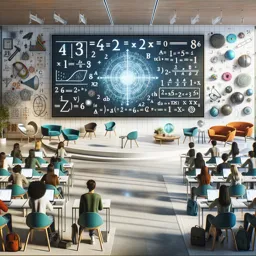Algebra is a branch of mathematics that deals with symbols and the rules for manipulating those symbols. It is a powerful tool used to solve problems in various fields and plays a crucial role in our daily lives, often in ways we may not immediately recognize. Understanding algebra can help us make informed decisions, solve problems efficiently, and understand patterns and relationships. Here are some real-world applications of algebra:
1. Personal Finance Management
Budgeting: Algebra helps in creating budgets by allowing us to set up equations that represent our income and expenses. For instance, if III represents income and EEE represents expenses, we can set up an equation like I−E=SI – E = SI−E=S, where SSS is savings.
Interest Calculations: Calculating compound and simple interest on savings accounts, loans, and credit cards involves algebraic formulas.
2. Cooking and Baking
Recipe Adjustments: Algebra helps in scaling recipes up or down. For example, if a recipe calls for 2 cups of flour to make 12 cookies, and you want to make 18 cookies, you can set up a proportion: 212=x18. Solving for xxx gives you the amount of flour needed for 18 cookies.
3. Home Improvement and Construction
Measurements and Conversions: Algebra is used to calculate area, volume, and conversions between units. For example, if you need to tile a floor, you can use the formula A=l×wA = l \times wA=l×w (where AAA is area, lll is length, and www is width) to determine the amount of tiles required.
Estimating Costs: When planning a home improvement project, algebra can help estimate costs by setting up equations that consider the price of materials and labor.
4. Health and Fitness
Calorie Counting: Algebra helps in managing diet plans by calculating the intake of calories, proteins, fats, and carbohydrates. For example, if a nutrition plan recommends 2000 calories per day, you can distribute this across meals using algebraic equations.
Exercise Regimens: Tracking progress in exercise, such as calculating the pace needed to run a certain distance in a specific time, involves algebra. For instance, if you want to run 5 miles in 50 minutes.
5. Travel and Transportation
Fuel Efficiency: Calculating fuel efficiency involves algebra. If a car travels ddd miles on ggg gallons of gas, the fuel efficiency EEE can be calculated using E=dgE = \frac{d}{g}E=gd.
Travel Planning: Algebra helps in determining travel times and distances. For instance, if you are traveling at a speed sss for a time ttt, the distance ddd can be calculated using d=s×td = s \times td=s×t.
6. Business and Economics
Profit and Loss Calculations: Businesses use algebra to calculate profits and losses. If RRR represents revenue and CCC represents costs, profit PPP can be calculated using P=R−CP = R – CP=R−C.
Break-Even Analysis: Algebra helps in determining the break-even point, where total revenue equals total costs. This can be found by setting up the equation R=CR = CR=C.
7. Technology and Engineering
Programming: Algebraic logic is fundamental in computer programming and algorithms. Variables, functions, and control structures in coding often use algebraic principles.
Engineering Design: Engineers use algebra to design and analyze systems and structures. For example, calculating the load a bridge can support involves algebraic equations.
8. Science
Chemistry: Algebra is used to balance chemical equations, calculate concentrations, and determine reaction yields.
Physics: Equations of motion, force, energy, and power all involve algebra. For example, Newton’s second law F=maF = maF=ma (force equals mass times acceleration) is a basic algebraic equation.
Conclusion
Algebra is a versatile tool that enhances problem-solving skills and logical thinking. Its applications are vast and diverse, impacting various aspects of everyday life. By understanding and utilizing algebra, we can make more informed decisions, optimize processes, and better understand the world around us.






























